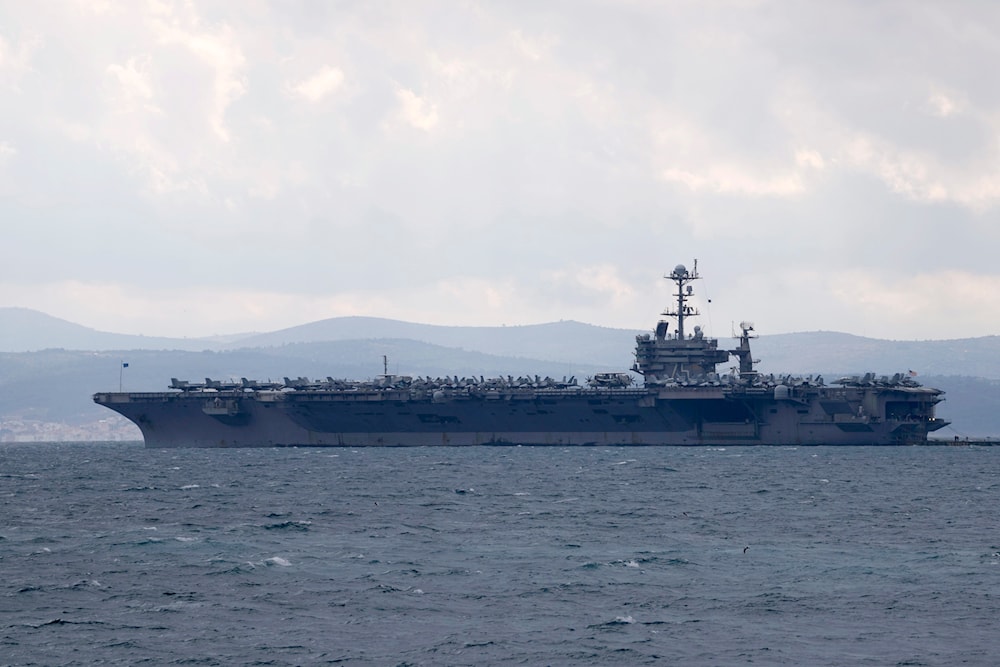US sends second aircraft carrier to ME, further militarizing region
The Pentagon's decision closely follows rising tensions between the US and Iran, as US President Donald Trump gives Iran a 2-month ultimatum to reach a nuclear deal.
-
 Aircraft carrier USS Harry S. Truman is moored near Split, Croatia, Feb. 14, 2022 (AP)
Aircraft carrier USS Harry S. Truman is moored near Split, Croatia, Feb. 14, 2022 (AP)
The Pentagon approved plans to send the USS Carl S. Vinson aircraft carrier to the Middle East, Al-Monitor reported, as the US continues to attack Yemen and President Donald Trump threatens Iran with military action.
The Secretary of Defense Pete Hegseth signed off orders to the USS Carl S. Vinson, a Nimitz-class carrier that was participating in military drills, to sail to the Middle East, extending its deployment by three months, according to Al-Monitor, citing a US official.
The Vinson is set to join the USS Harry S. Truman strike group, which has been involved in the campaign against Yemeni operations in the Red Sea and was expected to return to port at the end of the month.
Likewise, Hegseth extended the Truman’s deployment in the region for an additional month.
The deployments come amid rising tensions in the Middle East, with the US president ordering assaults on Yemen while threatening Iranian leaders to halt Tehran's nuclear program, despite it being peaceful as repeatedly affirmed.
This, according to AP, will be the second time in six months that the US has kept two carrier strike groups in that region, with generally only one there. Prior to that, it had been years since the US had committed that much warship power to the Middle East.
Wider context
Since returning to the White House for a second term in January, Trump reinstated his "maximum pressure" campaign of sanctions against Iran, echoing his strategy from his first presidency. In his initial term, Trump unilaterally withdrew from the 2015 nuclear agreement between Iran and world powers, reimposing sweeping economic sanctions.
Tehran initially continued to comply with the 2015 deal for a year after Washington’s withdrawal but later began scaling back its commitments. Although the Biden administration stated publically it wanted to revive the deal, negotiations stalled, leaving Iran unwilling to engage while sanctions remain in place.
Iran has consistently ruled out direct negotiations with the US while sanctions remain in place. Iranian Foreign Minister Abbas Araghchi recently reaffirmed this stance, stating that Iran "definitely will not negotiate directly while facing pressure, threats, and increased sanctions."
After reclaiming the presidency in January, Trump reinstated his "maximum pressure" policy, similar to his first term.
Iran reviews Trump's letters
According to IRNA on Monday, Iran is in the process of reviewing a letter from Trump, with a formal response to be issued once the assessment is complete, as Foreign Ministry spokesperson Esmail Baghaei stated during his weekly press briefing in Tehran nearly a week after the letter was received.
The correspondence, which Trump announced on March 7, was sent to Sayyed Ali Khamenei amid the administration's continued "maximum pressure" campaign on Iran, while also expressing an interest in negotiations.
Baghaei clarified that Tehran has no intention of making the letter public, emphasizing that media speculation does not necessarily reflect its content. He noted that its overall tone remains consistent with Trump's previous public remarks. Iran's response to this correspondence will be conveyed through diplomatic channels following a thorough review, he said. He also dismissed any link between the letter and Araghchi's visit to Oman, which had been scheduled in advance.

 4 Min Read
4 Min Read








